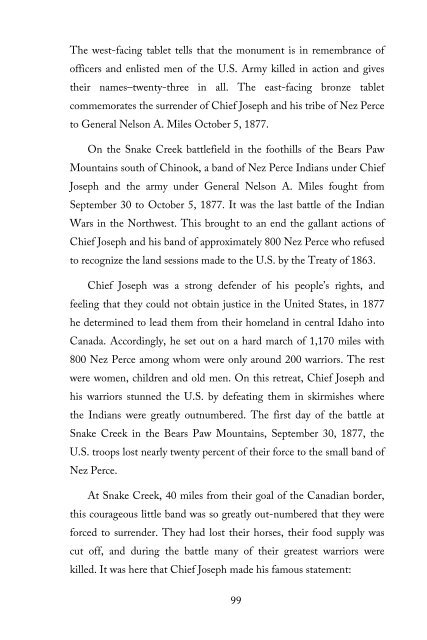Montana's DAR Markers . . . Honoring Where History Was Made
This book is a 200-page thank you to the women of Montana State Society Daughters of the American Revolution for their work in placing historical markers across the state of Montana. Starting in 1908, Montana DAR has installed 70 historical markers across the state. Of those, 33 remain. This book records why the markers’ sites were selected, their history, and the backstory of each.
This book is a 200-page thank you to the women of Montana State Society Daughters of the American Revolution for their work in placing historical markers across the state of Montana. Starting in 1908, Montana DAR has installed 70 historical markers across the state. Of those, 33 remain. This book records why the markers’ sites were selected, their history, and the backstory of each.
Create successful ePaper yourself
Turn your PDF publications into a flip-book with our unique Google optimized e-Paper software.
The west-facing tablet tells that the monument is in remembrance of<br />
officers and enlisted men of the U.S. Army killed in action and gives<br />
their names–twenty-three in all. The east-facing bronze tablet<br />
commemorates the surrender of Chief Joseph and his tribe of Nez Perce<br />
to General Nelson A. Miles October 5, 1877.<br />
On the Snake Creek battlefield in the foothills of the Bears Paw<br />
Mountains south of Chinook, a band of Nez Perce Indians under Chief<br />
Joseph and the army under General Nelson A. Miles fought from<br />
September 30 to October 5, 1877. It was the last battle of the Indian<br />
Wars in the Northwest. This brought to an end the gallant actions of<br />
Chief Joseph and his band of approximately 800 Nez Perce who refused<br />
to recognize the land sessions made to the U.S. by the Treaty of 1863.<br />
Chief Joseph was a strong defender of his people’s rights, and<br />
feeling that they could not obtain justice in the United States, in 1877<br />
he determined to lead them from their homeland in central Idaho into<br />
Canada. Accordingly, he set out on a hard march of 1,170 miles with<br />
800 Nez Perce among whom were only around 200 warriors. The rest<br />
were women, children and old men. On this retreat, Chief Joseph and<br />
his warriors stunned the U.S. by defeating them in skirmishes where<br />
the Indians were greatly outnumbered. The first day of the battle at<br />
Snake Creek in the Bears Paw Mountains, September 30, 1877, the<br />
U.S. troops lost nearly twenty percent of their force to the small band of<br />
Nez Perce.<br />
At Snake Creek, 40 miles from their goal of the Canadian border,<br />
this courageous little band was so greatly out-numbered that they were<br />
forced to surrender. They had lost their horses, their food supply was<br />
cut off, and during the battle many of their greatest warriors were<br />
killed. It was here that Chief Joseph made his famous statement:<br />
99





